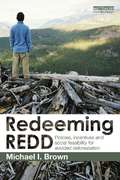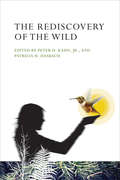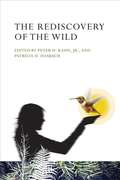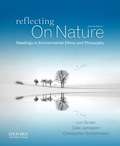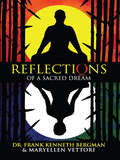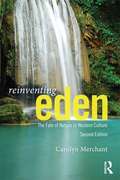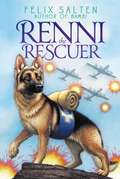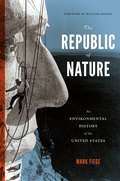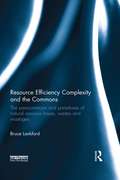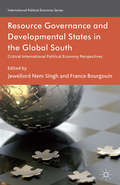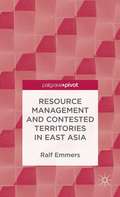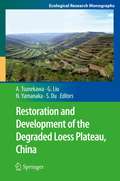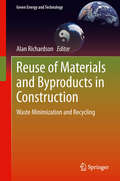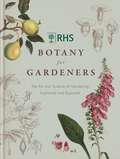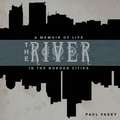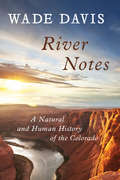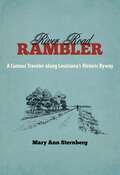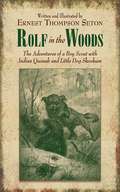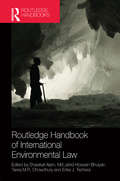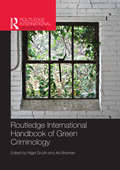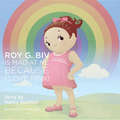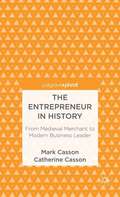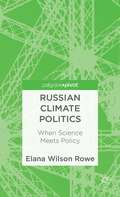- Table View
- List View
Redeeming REDD: Policies, Incentives and Social Feasibility for Avoided Deforestation
by Michael I. BrownIt is now well accepted that deforestation is a key source of greenhouse gas emissions and of climate change, with forests representing major sinks for carbon. As a result, public and private initiatives for reducing emissions from deforestation and forest degradation (REDD) have been widely endorsed by policy-makers. A key issue is the feasibility of carbon trading or other incentives to encourage land-owners and indigenous people, particularly in developing tropical countries, to conserve forests, rather than to cut them down for agricultural or other development purposes. This book presents a major critique of the aims and policies of REDD as currently structured, particularly in terms of their social feasibility. It is shown how the claims to be able to reduce greenhouse gas emissions as well as enhance people's livelihoods and biodiversity conservation are unrealistic. There is a naive assumption that technical or economic fixes are sufficient for success. However, the social and governance aspects of REDD, and its enhanced version known as REDD+, are shown to be implausible. Instead to enhance REDD's prospects, the author provides a roadmap for developing a new social contract that puts people first.
The Rediscovery of the Wild
by Peter H. Kahn Jr. Patricia H. HasbachA compelling case for connecting with the wild, for our psychological and physical well-being and to flourish as a species. We often enjoy the benefits of connecting with nearby, domesticated nature—a city park, a backyard garden. But this book makes the provocative case for the necessity of connecting with wild nature—untamed, unmanaged, not encompassed, self-organizing, and unencumbered and unmediated by technological artifice. We can love the wild. We can fear it. We are strengthened and nurtured by it. As a species, we came of age in a natural world far wilder than today's, and much of the need for wildness still exists within us, body and mind. The Rediscovery of the Wild considers ways to engage with the wild, protect it, and recover it—for our psychological and physical well-being and to flourish as a species.The contributors offer a range of perspectives on the wild, discussing such topics as the evolutionary underpinnings of our need for the wild; the wild within, including the primal passions of sexuality and aggression; birding as a portal to wildness; children's fascination with wild animals; wildness and psychological healing; the shifting baseline of what we consider wild; and the true work of conservation.
The Rediscovery of the Wild
by Patricia H. Hasbach Peter H. KahnWe often enjoy the benefits of connecting with nearby, domesticated nature -- a city park, a backyard garden. But this book makes the provocative case for the necessity of connecting with wild nature -- untamed, unmanaged, not encompassed, self-organizing, and unencumbered and unmediated by technological artifice. We can love the wild. We can fear it. We are strengthened and nurtured by it. As a species, we came of age in a natural world far wilder than today's, and much of the need for wildness still exists within us, body and mind. T he Rediscovery of the Wild considers ways to engage with the wild, protect it, and recover it -- for our psychological and physical well-being and to flourish as a species. The contributors offer a range of perspectives on the wild, discussing such topics as the evolutionary underpinnings of our need for the wild; the wild within, including the primal passions of sexuality and aggression; birding as a portal to wildness; children's fascination with wild animals; wildness and psychological healing; the shifting baseline of what we consider wild; and the true work of conservation.The hardcover edition does not include a dust jacket.
Reflecting on Nature: Readings in Environmental Ethics and Philosophy
by Lori Gruen Dale Jamieson Christopher SchlottmannSpanning centuries of philosophical and environmental thought, this book, will inform and enlighten your students while also encouraging debate. <p><p> Extensively revised and updated for the second edition, this comprehensive collection presents fifty classic and contemporary readings, thirty-three of them new. This book retains the core readings and insights of the first edition while also updating its coverage in light of the many changes that have occurred over the last twenty years in the intellectual climate and in patterns of environmental concern. The selections are topically organized into sections on animals, biodiversity, ethics, images of nature, wilderness, and―new to this edition―aesthetics, climate change, food, and justice. This thematic organization, in combination with coverage of current environmental issues, encourages students to apply what they learn in class to real-life problems. <p><p> Featuring insightful section introductions, discussion questions, and suggestions for further reading, this book is ideal for use in environmental philosophy, environmental ethics, and environmental studies courses.
Reflections of a Sacred Dream
by Dr Frank Kenneth Bergman Maryellen VettoriThrough the influence of Japanese-inspired haiku, stop and evaluate your current state of mind. Are you focused on spending your time and thoughts on accumulation of material items that will be gone tomorrow? Is your mind filled with stress and worry about seemingly important matters that will not matter in time to come? Throughout the poetry in this illustrated book, free your mind and look around you right where you are at the present time. See for yourself the spiritual beauty of nature as it unfolds in front of your senses every day. Study the concepts of balance and harmony in the universe. Only then can you appreciate what you are sharing with everything else in your universe as you travel on your sacred journey.
Reinventing Eden: The Fate of Nature in Western Culture
by Carolyn MerchantThis revised edition of Carolyn Merchant’s classic Reinventing Eden has been updated with a new foreword and afterword. Visionary quests to return to the Garden of Eden have shaped Western Culture. This book traces the idea of rebuilding the primeval garden from its origins to its latest incarnations and offers a bold new way to think about the earth.
Renni the Rescuer
by Felix Salten Kenneth C. KaufmanFrom the author of Bambi, this story of a boy, his dog, and their bravery reaches a new generation of readers with a fresh look.George has always wanted a dog, so when he picks up small Renni, the runt of a litter of German Shepherd puppies, he immediately falls in love. As Renni grows, George begins to teach him, and soon Renni is able to do remarkable things. When a trainer suggests Renni become a rescue dog, George knows it's a perfect fit for his pet. Soon Renni is able to find anyone in any situation. Then the war that has been looming finally begins, and Renni and George enlist. They are able to help many soldiers during training camp--but when they are tested in the actual battlefield, can the two friends hold their ground? Or are they unprepared for the trials ahead?
The Republic Of Nature: An Environmental History Of The United States (Weyerhaeuser Environmental Bks.)
by Mark Fiege William CrononIn the dramatic narratives that comprise The Republic of Nature, Mark Fiege reframes the canonical account of American history based on the simple but radical premise that nothing in the nation's past can be considered apart from the natural circumstances in which it occurred. Revisiting historical icons so familiar that schoolchildren learn to take them for granted, he makes surprising connections that enable readers to see old stories in a new light.
Resource Efficiency Complexity and the Commons: The Paracommons and Paradoxes of Natural Resource Losses, Wastes and Wastages
by Bruce LankfordThe efficient use of natural resources is key to a sustainable economy, and yet the complexities of the physical aspects of resource efficiency are poorly understood. In this challenging book, the author proposes a major advance in our understanding of this topic by analysing resource efficiency and efficiency gains from the perspective of common pool resources, applying this idea particularly to water resources and its use in irrigated agriculture. The author proposes a novel concept of "the paracommons", through which the savings of increased resource efficiency can be viewed. In effect he asks; "who gets the gain of an efficiency gain?" By reusing, economising and avoiding losses, wastes and wastages, freed up resources are available for further use by four ‘destinations’; the same user, parties directly connected to that user, the wider economy or returned to the common pool. The paracommons is thus a commons of – and competition for – resources salvaged by changes to the efficiency of natural resource systems. The idea can be applied to a range of resources such as water, energy, forests and high-seas fisheries. Five issues are explored: the complexity of resource use efficiency; the uncertainty of efficiency interventions and outcomes; destinations of freed up losses, wastes and wastages; implications for resource conservation; and the interconnectedness of users and systems brought about by efficiency changes. The book shows how these ideas put efficiency on a par with other dimensions of resource governance and sustainability such as equity, justice, resilience and access.
Resource Governance and Developmental States in the Global South
by Jewellord Nem Singh F. BourgouinThe political economy landscape has shifted as multinational corporations increase their investment efforts, changing the geographies of extraction. The contributors make the argument for the need of new theoretical perspectives anchored in critical political economy to address structural dynamics in the global industry.
Resource Management and Contested Territories in East Asia
by Ralf EmmersRalf Emmers discusses the significance of natural resources as a source of inter-state cooperation and competition in East Asia, assessing whether the joint exploration and development of resources can act as a means to reduce tensions in contested territories. Does the joint management of natural resources in the absence of a negotiated maritime delimitation constitute a feasible strategy to de-escalate maritime sovereignty disputes in East Asia? Can cooperative resource exploitation be separated from nationalist considerations and power politics calculations? Alternatively, should the prospect for joint exploration in disputed waters be expected to raise rather than defuse territorial conflicts, especially if abundant resources are eventually discovered? If this were true, should exploration schemes be postponed until sovereignty disputes have been resolved? Emmers addresses these questions by examining the overlapping sovereignty claims in the Sea of Japan and the East and South China Seas.
Restoration and Development of the Degraded Loess Plateau, China
by Norikazu Yamanaka Sheng Du Atsushi Tsunekawa Guobin LiuThis book presents state-of-the-art scientific evidence and technological innovations to restore lands on the Loess Plateau of China, known worldwide for its serious land degradation and desertification problems. Supported by a rapidly developing Chinese economy and the dissemination of effective technology, the Grain-for-Green Project and Western Development Action launched by the Chinese government have resulted in successful ecological restoration and protection over the past 30 years. These programs have contributed not only to conservation of soil and water, but also to economic development. At the same time, however, these developmental interventions have brought new challenges that have not yet been fully addressed. The book describes (1) case studies of success and failure in practice, including rare success stories of combating desertification; (2) technical issues such as erosion control and breeding of stress-tolerant plant species, and socioeconomic measures taken by the Chinese government and lending policies with support from the World Bank; and (3) comprehensive measures against desertification, such as water and wind erosion, salinization, and deforestation. This volume is recommended for researchers and students above the undergraduate level in diverse fields including soil science, rural engineering, social technology and civil engineering, biology, ecology, climatology, physical and human geography, and developmental economics, among others. It also serves as a valuable resource for engineers, government officials, and NPOs and NGOs involved in afforestation, ecological restoration, combating desertification, disaster prevention, and sustainable rural development.
Reuse of Materials and Byproducts in Construction
by Alan RichardsonThe construction industry is the largest single waste producing industry in the UK. Ensuring a supply chain of recycled materials affords many potential gains, achieved through: reducing the material volume transported to already over-burdened landfill sites, possible cost reductions to the contractor/client when considering the landfill tax saved and the potential for lower cost material replacements, a reduction in the environmental impact of quarrying and the saving of depleting natural material resources. Reuse of Materials and Byproducts in Construction: Waste Minimization and Recycling addresses use of waste and by products in the construction industry. An over view of new "green" design guides to encourage best practice will be examined and current legislation that channels on site practices, such as site waste management plans. Fundamental individual construction materials are discussed and the process of reforming by products and waste products into new construction materials is investigated, examining the material performance, energy required to convert waste into new products and viability of recycling. The main range of constructional materials will be examined. Aimed at postgraduate students, lecturers and researchers in construction and civil engineering, the book will also be of interest to professional design practices.
RHS Botany for Gardeners: The Art and Science of Gardening Explained & Explored
by Royal Horticultural Society'Clever... valuable introduction to the study of plant science.' - Gardeners IllustratedRHS Botany for Gardeners is more than just a useful reference book on the science of botany and the language of horticulture - it is a practical, hands-on guide that will help gardeners understand how plants grow, what affects their performance, and how to get better results. Illustrated throughout with beautiful botanical prints and simple diagrams, RHS Botany for Gardeners provides easy-to-understand explanations of over 3,000 botanical words and terms, and show how these can be applied to everyday gardening practice. For easy navigation, the book is divided into thematic chapters covering everything from Plant Pests, and further subdivided into useful headings such as 'Seed Sowing' and 'Pruning'. 'Botany in Action' boxes provide instantly accessible practical tips and advice, and feature spreads profile the remarkable individuals who collected, studied and illustrated the plants that we grow today. Aided by this book, gardeners will unlock the wealth of information that lies within the intriguing world of botanical science - and their gardens will thrive as a result. This is the perfect gift for any gardener.Contents Includes...The Plant kingdomGrowth, Form and FunctionInner WorkingsReproductionThe Beginning of LifeExternal FactorsPruningBotany and the SensesPest, Diseases and DisordersBotanists and Botanical Illustration... And Much More!
The River
by Paul Vasey"Ask anyone what they love most about Winzer, and they seem always to tell you it's the people, the family and friends webbed around each of us. True. But for me the town is also, and perhaps mainly, the larger-than-life characters who ghost around in my imagination and my memory: rumrunners and prize fighters and elegant old ladies and one-eyed thugs and earnest well-meaning politicians and hucksters and hookers and crusty old editors. Many of them I remember meeting. Some of them I actually met." -from The RiverThe River is Paul Vasey's tribute to a place he discovered by accident and loved over a lifetime. Chatty, anecdotal, personal and passionate, by one of Windsor's most celebrated reporters and radio hosts, this meandering memoir winds its way around a river town whose sights and characters may never be fully charted: a Windsor that fired a reporter's imagination, stole his heart, and eventually became the place he calls home.
River Notes: A Natural and Human History of the Colorado
by Wade DavisPlugged by no fewer than twenty-five dams, the Colorado is the world's most regulated river drainage. The Colorado River provides most of the water supply of Las Vegas, Tucson, and San Diego, and much of the power and water of Los Angeles and Phoenix, cities that are home to more than 25 million people. If it ceased flowing, the water held in its reservoirs might hold out for three to four years, but after that it would be necessary to abandon most of southern California and Arizona, and much of Colorado, New Mexico, Utah and Wyoming. For the entire American Southwest the Colorado is indeed the river of life, which makes it all the more tragic and ironic that by the time it approaches its final destination, it has been reduced to a shadow upon the sand, its delta dry and deserted, its flow a toxic trickle seeping into the sea. In this remarkable blend of history, science, and personal observation, acclaimed author Wade Davis tells the story of America's Nile, how it once flowed freely and how human intervention has left it near exhaustion, altering the water temperature, volume, local species, and shoreline of the river Theodore Roosevelt once urged us to "leave it as it is." Yet despite a century of human interference, Davis writes, the splendor of the Colorado lives on in the river's remaining wild rapids, quiet pools, and sweeping canyons. The story of the Colorado River is the human quest for progress and its inevitable if unintended effects--and an opportunity to learn from past mistakes and foster the rebirth of America's most iconic waterway. A beautifully told story of historical adventure and natural beauty, River Notes is a fascinating journey down the river and through mankind's complicated and destructive relationship with one of its greatest natural resources.
River Road Rambler: A Curious Traveler along Louisiana's Historic Byway (Southern Literary Studies)
by Mary Ann SternbergThe River Road between New Orleans and Baton Rouge hosts a fascinating mix of people, traditions, and stories. Author Mary Ann Sternberg has spent over two decades exploring this historic corridor, uncovering its intriguing and often-underappreciated places. In River Road Rambler, she presents fifteen sketches about sites along this scenic route. From familiar stops, such as the National Hansen's Disease Center Museum at Carville and the perique tobacco area of St. James Parish to lesser-known attractions such as Our Lady of Lourdes grotto in the town of Convent and the Colonial Sugars Historic District, Sternberg provides a new perspective on some of the region's most colorful places. While many of these locales remain easily accessible to any River Road rambler, Sternberg also depicts others closed to the public, giving armchair travelers an introduction to these otherwise unreachable attractions. Throughout, Sternberg captures the ambiance of her surroundings with a clear, engaging, and personal examination of the relationships between past and present. In a poignant piece on the garden of "Valcour" Aime, for example, she delves into the history of this lavish, nationally acclaimed planter's garden, established and abandoned in the mid-nineteenth century. Her visit to the now-private and protected site, which has never been altered or replanted, uncovers an extraordinary landscape -- the relic of what Aime created, slowly overwhelmed by nature. These sketches brim with insights and observations about everything from the fire that razed The Cottage plantation to the failed attempts to salvage the reproduction of the seventeenth-century French warship Le Pelican from the bottom of the Mississippi. River Road Rambler links us to both past and present while revealing delightful and unexpected surprises only found along this storied byway.
The Rock Garden (Fountas & Pinnell LLI Gold #Level P)
by Nancy WhiteStep into the Rock Garden of Chandigarh in India, it's like entering a magical world.
Rolf in the Woods: The Adventures of a Boy Scout with Indian Quonab and Little Dog Skookum
by Ernest Thompson SetonSet at the beginning of the nineteenth century, Rolf in the Woods follows a young boy on his journey to becoming a man, learning how to live in the wilderness, respecting animals and nature, and fighting amongst his brethren in war. When his mother passes away, fifteen-year-old Rolf goes to live with his aunt and uncle on their farm. But his aunt's constant scolding and his uncle's drunken violence make living in this new home unbearable for the gentle boy, and he runs away to live in a wigwam with Quonab, a Native American, and his trusty dog Skookum, who teach the boy how to live off the land, hunt, gather, and understand wild creatures. These newfound skills come into play when Rolf must participate in the War of 1812, and he is able to survive by relying on the wisdom the Indian has shared with him. Rolf in the Woods is not only an adventure story but also a guide that teaches young men how to thrive in the outdoors. Ernest Thompson Seton, an avid outdoorsman, provides vivid descriptions of Quonab's lessons, like making a bed with logs, constructing a tom-tom, distinguishing the calls of animals, and making a bow and arrow, and includes over 200 hand-drawn illustrations to make these lessons come to life.
Routledge Handbook of International Environmental Law
by Shawkat Alam Md Jahid Hossain Bhuiyan Tareq M.R. Chowdhury Erika J. TecheraThe Routledge Handbook of International Environmental Law is an advanced level reference guide which provides a comprehensive and contemporary overview of the corpus of international environmental law (IEL). The Handbook features specially commissioned papers by leading experts in the field of international environmental law, drawn from a range of both developed and developing countries in order to put forward a truly global approach to the subject. Furthermore, it addresses emerging and cross-cutting issues of critical importance for the years ahead. The book is split into six parts for ease of reference: The Legal Framework, Theories and Principles of International Environmental Law - focuses on the origins, theory, principles and development of the discipline; Implementing International Environmental Law - addresses the implementation of IEL and the role of various actors and institutions, including corporations, intergovernmental organisations and NGOs; Key Issues and Legal Frameworks - brings fresh perspectives of the common general issues of international environmental law, such as biological diversity and marine environmental law; Regional Environmental Law - explores the specific regimes developed to address regional environmental issues, considering the evolution, prospects and relationship of regional law and mechanisms to IEL; Cross-Cutting Issues - considers the engagement of international environmental law with other key fields and legal regimes, including international trade, human rights and armed conflict; Contemporary and Future Challenges - analyses pressing current and emerging issues in the field including environmental refugees and climate change, REDD and deforestation, and ‘treaty congestion’ in IEL. This up-to-date and authoritative book makes it an essential reference work for students, scholars and practitioners working in the field.
Routledge International Handbook of Green Criminology (Routledge International Handbooks)
by Nigel South Avi BrismanAcademic and general interest in environmental crimes, harms, and threats, as well as in environmental legislation and regulation, has grown sharply in recent years. The Routledge International Handbook of Green Criminology is the most in-depth and comprehensive volume on these issues to date. With contributions from leading international green criminologists and scholars in related fields, the Handbook examines a wide range of substantive issues, including: climate change corporate criminality and impacts on the environment environmental justice media representations pollution (e.g. air, water) questions of responsibility and risk wildlife trafficking The chapters explore green criminology in depth, its theory, history and development, as well as methodological concerns for this area of academic interest. With examples of environmental crimes, harms, and threats from Africa, Asia, Australia, Eastern Europe, South America, the United Kingdom, and the United States, this book will serve as a vital resource for international scholars and students in criminology, sociology, law and socio-legal studies, as well as environmental science, environmental studies, politics and international relations.
Roy G. Biv Is Mad at Me Because I Love Pink!
by Nancy Guettier&“A cute story that teaches the colors of the rainbow&” from the author of Mermaids on Mars and Circus in the Sky (The Naptime Reviewer). Roy G. Biv Is Mad at Me Because I Love Pink! is an educational and playful story about learning of the colors of the rainbow. Roy G. Biv is an acronym for the sequence of the hues in the rainbow: Red, Orange, Yellow, Green, Blue, Indigo, Violet. &“Singer-songwriter and children&’s book author Nancy Guettier finds inspiration in each of her kids to write entertaining children&’s stories. Guettier&’s style is whimsical and fun, making learning effortless . . . Roy G. Biv Is Mad at Me Because I Love Pink! is centered around Genevieve who loves splashing in puddles after a rain shower. Mostly, Genevieve loves pink; however, pink is not a color in the rainbow. Understandably that upsets Roy G. Biv, who convinces her to experience all the colors of the rainbow.&” —MySocialGoodNews.com &“Your children will dive in to Genevieve&’s adventure with Roy G. Biv, as he tries to show her that pink is a fine color but she should try other ones as well. Your toddler will learn so much about colors and will be able to associate them with colorful objects they may encounter in their everyday routine.&” —TheBabySpot.ca
Rule of Law for Nature
by Christina Voigt'Human laws must be reformulated to keep human activities in harmony with the unchanging and universal laws of nature. ' This 1987 statement by the World Commission on Environment and Development has never been more relevant and urgent than it is today. Despite the many legal responses to various environmental problems, more greenhouse gases than ever before are being released into the atmosphere, biological diversity is rapidly declining and fish stocks in the oceans are dwindling. This book challenges the doctrinal construction of environmental law and presents an innovative legal approach to ecological sustainability: a rule of law for nature which guides and transcends ordinary written laws and extends fundamental principles of respect, integrity and legal security to the non-human world.
Russian Climate Politics: When Science Meets Policy
by Elana Wilson RoweCovering the period c. 1200-c. 2000, this book provides an innovative investigation of entrepreneurship in a long-run historical perspective, presenting new insights into the personal characteristics of successful business people and deepening our understanding of the roots of industrialization and economic growth.
Russian Climate Politics: When Science Meets Policy
by Elana Wilson RoweRussia remains among the top-5 greenhouse gas emitters in the world and thus an important player in the field of international climate politics. To gain a deeper understanding of how Russian climate politics is formed, the changing and somewhat unexpected role scientists and scientific knowledge play in shaping Russian policymaking is explored.
